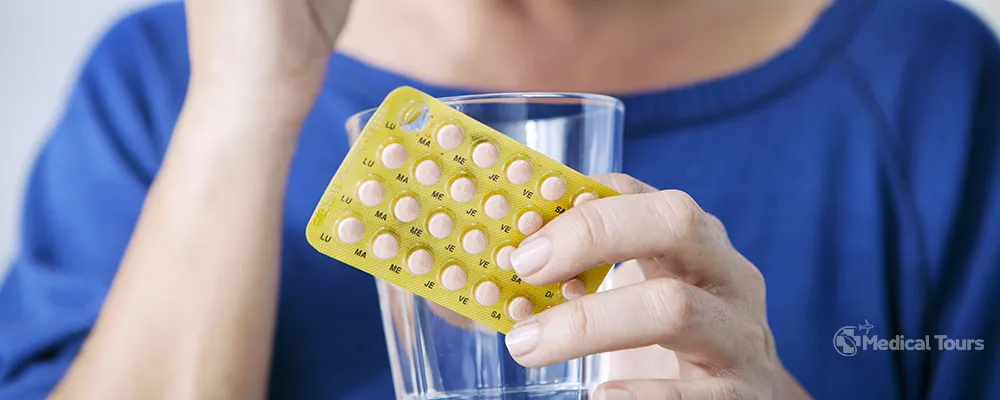Hormone Replacement Therapy, also known as HRT, is a therapy method for providing women with adequate amounts of the female hormones, oestrogen, and progesterone as their bodies' natural production declines with age. HRT is used to treat a variety of ailments, but it is most typically used to help women cope with the symptoms of menopause. Symptoms of menopause vary in duration and severity, but most women experience unpleasant hot flashes, sweating, abdominal pain, and mood swings, among other things. HRT assists women in replacing their depleted hormones, hence alleviating all these symptoms.
Whether or not to use postmenopausal hormone therapy is a critical health decision. The Women's Health Initiative and other research are giving crucial information on the risks and benefits of long-term menopausal hormone therapy, allowing women to make informed decisions about their hormone use.
Hormones are proteins or chemicals produced by the body that serve to regulate the function of specific types of cells. Some portions of the body, for example, are dependent on sex hormones like estrogen, testosterone, and progesterone to function effectively. Thyroid hormones, cortisol, adrenaline, and insulin are among the other hormones found in human systems. Different organs or glands produce different types of hormones.
Hormones are required for the growth of several malignancies. As a result, hormone-blocking or -altering medications can occasionally help delay or stop the progression of certain tumours.
Hormone treatment, also known as hormonal therapy or endocrine therapy, is a method of treating cancer with hormones. Hormone treatment is mostly used to treat breast and prostate cancers that rely on sex hormones to thrive. Hormone therapy can also be used to treat a few other malignancies.
Because the hormones targeted by hormone therapy flow throughout the body, it is considered a systemic treatment. Hormone therapy medications travel throughout the body to target and locate hormones. This distinguishes it from treatments that target a single bodily component, such as most types of surgery and radiation therapy. These kinds of therapies are known as local treatments since they only affect one portion of the body. (However, as noted below, surgery to remove hormone-producing organs can also be employed as a sort of hormone treatment.)
The following information explains how hormone treatment is used to treat cancer. If you are a transgender person with cancer and hormone therapy is a possibility for treatment, speak with your cancer care team to learn more about how the treatment will influence your situation.
Hormone Therapy costs in India may be around USD 6000 (INR 468366) to 8000 (INR 624488). It could differ according to your location and hospital and doctor experience.
Hormone therapy searches the entire body for and targets hormones. Hormone therapy works in different ways for different people. They can:
Hormone treatment can be used to:
Hormone therapy is divided into numerous categories. Here are a few instances of cancers that can be treated.
Following the NIH's termination of the estrogen-alone trial, we have updated you with new information. One of the most crucial health considerations women make as they age is whether or not to take menopausal hormone therapy (MHT). We have compiled the most up-to-date research to provide information on the dangers and advantages of MHT. It is intended to give patients information that will help them communicate more effectively with their doctors and choose the best course of therapy for them. Menopause and Hormone Therapy, Alternatives to Hormone Therapy to Help Prevent Postmenopausal Conditions and Relieve Menopausal Symptoms, Dietary Supplements, and other topics are covered here.
The WHI's long-term investigations were started because a few research studies had presented a complicated picture of the dangers and benefits of hormone therapy over the years, and its continued use for cardiovascular disease prevention was controversial. As a result of this circumstance, the National Institutes of Health decided to launch massive clinical research to assess the risks and benefits of hormone therapy. The goal of the WHI was to look at the long-term effects of estrogen plus progestin on heart disease and hip fracture prevention, as well as prospective increases in breast and colon cancer risk. Because progestin is known to protect against endometrial cancer, which is a known side effect of unopposed estrogen, the estrogen plus progestin regimen was administered to women with uteruses. Separate research of estrogen alone in hysterectomy patients is in underway.
Women who were given active hormones were given 0.625 mg of conjugated equine estrogens and 2.5 mg of medroxyprogesterone acetate each day. In the United States, this is the most widely recommended postmenopausal hormone therapy for women who have a uterus (used each day by more than six million women).
Other hormone drugs, such as various estrogens or progestins, cannot be recommended in detail. You also can not give or take advice on hormones that women take in lower doses or in alternative forms, such as patches rather than pills. Furthermore, without scientific clinical trial data, alternative estrogen plus progestin therapy cannot be assumed to be any safer than those investigated in WHI.
Other changes associated with menopause may occur without causing symptoms but still have an impact on your health. Women and their bone loss rates, for example, increase after menopause. The higher rate can cause osteoporosis, which can raise the risk of bone fractures. Heart disease risk rises with age, but it is not firmly linked to menopause. Studies have found evidence that estrogen may aid with some of these postmenopausal health problems, particularly heart disease and osteoporosis, over time. With more than 40 million women over the age of 50 in the United States, the potential looked enormous. Heart disease is the biggest cause of death among American women, even though many women believe it is a "man's disease." It usually takes a woman ten years longer than a man to develop it. Women are also more susceptible to osteoporosis than men
Menopause is associated with an increase in bone loss. Bone is a type of living tissue. Old bone is constantly being broken down and replaced by new bone. Menopause causes increased bone loss, which, if not replaced, can lead to weakening bones and osteoporosis, which raises the risk of fractures. Over the course of her life, one out of every two women over the age of 50 will suffer an osteoporosis-related fracture. Many scientists assumed that the decline in estrogen generated by the ovaries after menopause was linked to the increased health risks, and that supplementing estrogen would help guard against the diseases.
Finally, the WHI findings provide women with advice on how to take menopausal hormone treatment. They establish a causal relationship between the use of the medicines studied and the disorders they treat. Furthermore, the findings are generalizable, the studies discovered no significant variations in risk based on prior health status, age, or ethnicity. As you read the following information, keep in mind that most therapies have risks and benefits. Consult your doctor or other health care practitioner to determine the best course of action for your health and quality of life. Start by determining your personal risk of heart disease, stroke, breast cancer, osteoporosis, colorectal cancer, and other diseases. Discuss concerns of quality of life and menopausal hormone therapy alternatives. Make sure you prepare yourself in communicating with your health-care provider. Then carefully consider each factor and select the best solution for your health and quality of life. Keep the conversation going, your health situation, as well as your decision, can change.
Hormone therapy can decrease the tumour in 85 percent to 90 percent of patients with advanced prostate cancer.
Risks: Tamoxifen concerns include blood clots, stroke, bone loss, mood changes, depression, and loss of libido drive, in addition to the more frequent side effects of hormone therapy like hot flashes. Tamoxifen can cause headaches, nausea, vomiting, rashes, impotence, and a lack of libido drive in men.
These are some of the probable negative effects for women receiving hormone therapy for breast or endometrial cancer:

